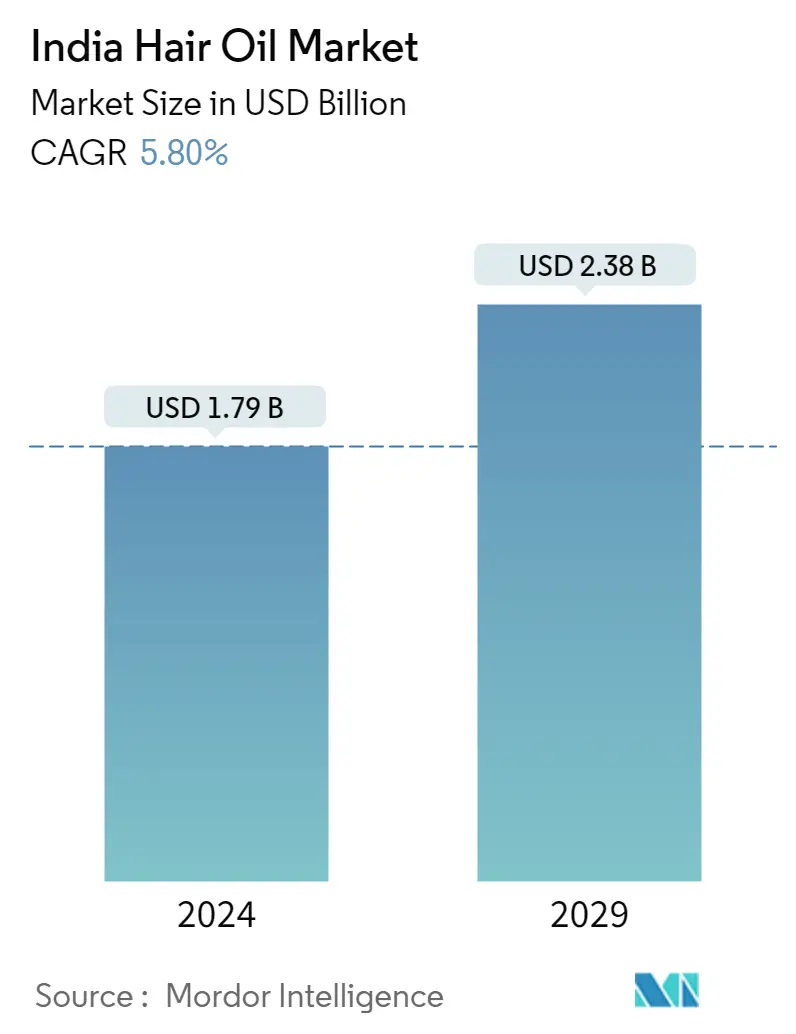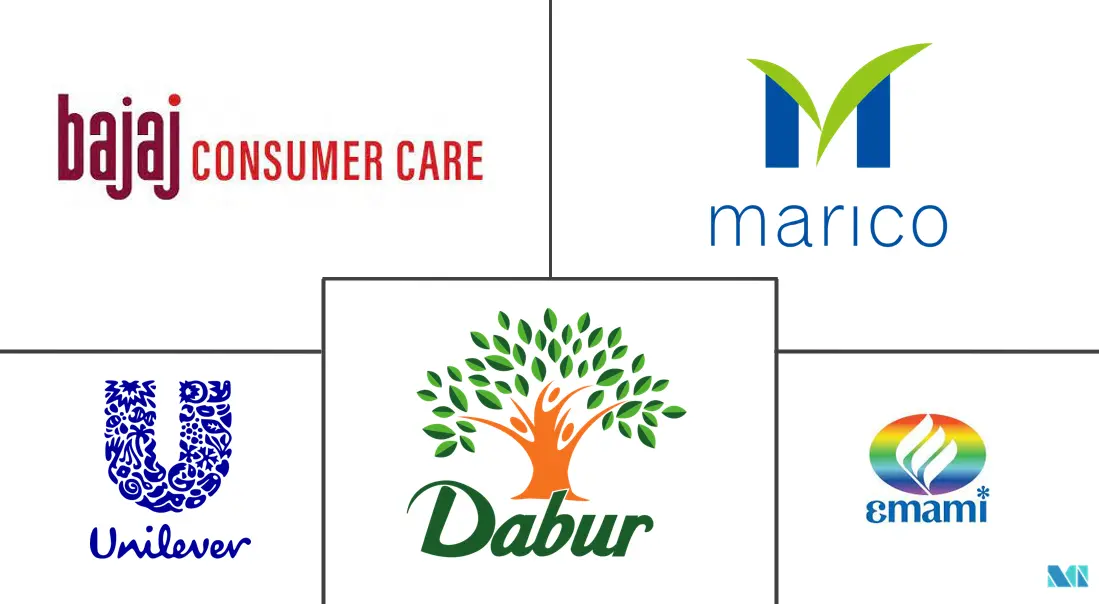Market Size of India Hair Oil Industry

| Study Period | 2019 - 2029 |
| Base Year For Estimation | 2023 |
| Market Size (2024) | USD 1.79 Billion |
| Market Size (2029) | USD 2.38 Billion |
| CAGR (2024 - 2029) | 5.80 % |
| Market Concentration | Low |
Major Players
*Disclaimer: Major Players sorted in no particular order |
Need a report that reflects how COVID-19 has impacted this market and its growth?
India Hair Oil Market Analysis
The India Hair Oil Market size is estimated at USD 1.79 billion in 2024, and is expected to reach USD 2.38 billion by 2029, growing at a CAGR of 5.80% during the forecast period (2024-2029).
India has been a prominent market for hair oil over generations due to the practice of oiling the head regularly. With India taking a strong lead in hair oils due to its well-established hair-oiling rituals, numerous brands are offering differentiated products for different demographics of the country. The main categories of hair oil available in India are coconut hair oils, amla hair oils, light hair oils, and cooling hair oils. Among these, coconut oil is largely used across the country, especially in South India. The heat and humidity in the country are often associated with dry and greasy hair. Thereby changing climatic conditions are increasing the use of hair oil to prevent hair damage, positively impacting the market growth.
Hair gets dry and damaged due to pollution. Consumers are tremendously moving toward hair oils, as the massage of hair oils on the scalp can prevent dryness and increase hair volume. Hair oils are one of the best hair care products, and consumers prefer these products, which is driving the market. The rising demand for light hair oil among consumers also enables players to innovate new hair oil products and have consistency in innovation. Offering different hair oils to consumers is a significant factor in increasing the per capita spending in this market.
India Hair Oil Industry Segmentation
Hair oil is an oil-based personal care product intended to improve the condition of hair. The Indian hair oil market is segmented by type and distribution channel. By type, the market is segmented into coconut oil, almond oil, amla oil, castor oil, and other types. Further, based on distribution channels, the market is segmented into supermarkets/hypermarkets, convenience stores, online stores, and other distribution channels. For each segment, the market sizing and forecasts have been done on the basis of value (in USD million).
| Type | |
| Coconut Oil | |
| Almond Oil | |
| Amla Oil | |
| Castor Oil | |
| Other Types |
| Distribution Channel | |
| Supermarkets/Hypermarkets | |
| Convenience Stores | |
| Online Stores | |
| Other Distribution Channels |
India Hair Oil Market Size Summary
The India Hair Oil Market is experiencing substantial growth, driven by the country's long-standing tradition of hair oiling. The market is segmented into different types of hair oils including coconut hair oils, amla hair oils, light hair oils, and cooling hair oils, with coconut oil being the most widely used. The changing climatic conditions in the country, which often result in dry and greasy hair, have led to an increase in the use of hair oil to prevent hair damage. Additionally, the rising pollution levels have also prompted consumers to turn to hair oils as a remedy for dry and damaged hair. This, coupled with the increasing demand for light hair oil, is driving innovation in the market and boosting market growth. The Indian Hair Oil Market is also witnessing a shift in consumer preference towards organic and herbal hair oil products due to growing awareness about the potential harm of chemical products. Hair oils with herbal ingredients are perceived to offer nourishment and better results, leading to an increase in demand. Furthermore, the use of hair oil is not just limited to hair care, but also extends to relaxation and stress relief. The industry is highly competitive with numerous local and global players, including Unilever Company, Marico, Dabur, Emami, and Bajaj, who are actively involved in product innovation and strategic mergers and acquisitions to maintain their market dominance.
Explore MoreIndia Hair Oil Market Size - Table of Contents
-
1. MARKET DYNAMICS
-
1.1 Market Drivers
-
1.2 Market Restraints
-
1.3 Porter's Five Forces Analysis
-
1.3.1 Threat of New Entrants
-
1.3.2 Bargaining Power of Buyers/Consumers
-
1.3.3 Bargaining Power of Suppliers
-
1.3.4 Threat of Substitute Products
-
1.3.5 Intensity of Competitive Rivalry
-
-
-
2. MARKET SEGMENTATION
-
2.1 Type
-
2.1.1 Coconut Oil
-
2.1.2 Almond Oil
-
2.1.3 Amla Oil
-
2.1.4 Castor Oil
-
2.1.5 Other Types
-
-
2.2 Distribution Channel
-
2.2.1 Supermarkets/Hypermarkets
-
2.2.2 Convenience Stores
-
2.2.3 Online Stores
-
2.2.4 Other Distribution Channels
-
-
India Hair Oil Market Size FAQs
How big is the India Hair Oil Market?
The India Hair Oil Market size is expected to reach USD 1.79 billion in 2024 and grow at a CAGR of 5.80% to reach USD 2.38 billion by 2029.
What is the current India Hair Oil Market size?
In 2024, the India Hair Oil Market size is expected to reach USD 1.79 billion.
